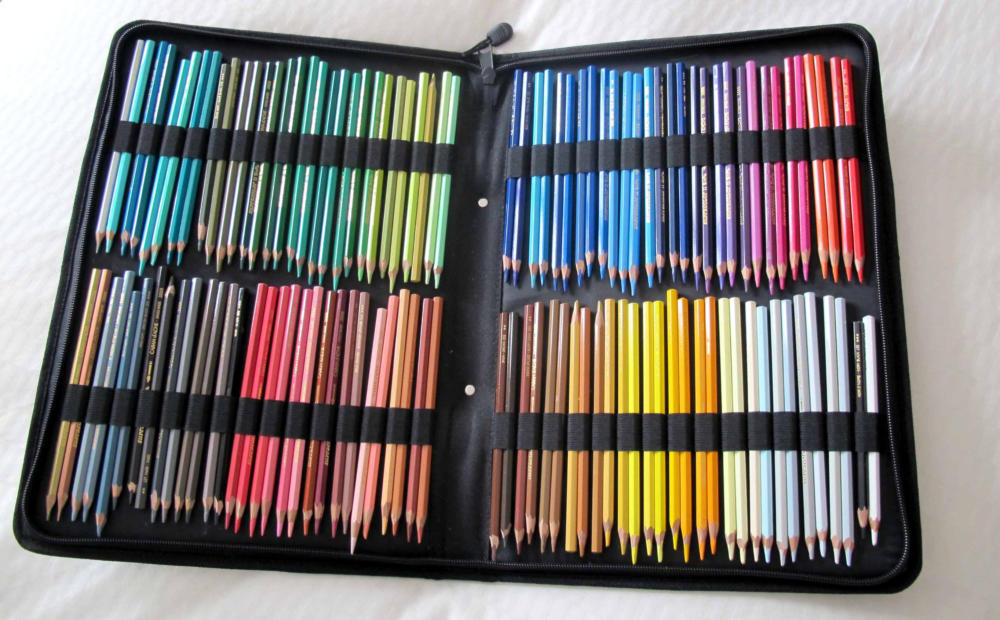- Home
- Pencil brands
- Lightfastness Tests
Lightfastness test results - Judith Crown
In June 2018, a comprehensive set of lightfastness tests have been published here which originate from several years of work by Judith Crown.
Sets of sample strips from most brands have been subjected to the strong sunlight of Israel for upwards of 12 weeks at a time - equivalent to many years of more temperate UK sunlight. The resulting tests are shown below.
They make good reading, and are exceedingly useful, but bear in mind that they are NOT scientific tests. They have been carried out in a similar way, but not at the same time. Comparisons can only be properly made within a brand and not between brands.
Please read the forward below on this page carefully.
How the lightfastness test was performed
In June 2018, Judith Crown passed on her lightfastness tests to Pencil Topics for publishing on the Web. Judith is an experienced Coloured Pencil artist and a Gold Signature Member of the UK Coloured Pencil Society ( UKCPS ).
Judith has had a long standing interest in the problems of fading colour and she looks at the testing, not from a scientific point of view, but from the point of view of a practicing artist who wants her work to last and needs to identify the colours in her palette that are most at risk from disappearing.
These tests have been ongoing for several years and the tests have been refined over that time, but the basic principle is unchanged - namely that each colour from a pencil set is repeated three times and one set is retained as a control in a dark folder. The second is treated with Winsor & Newton Fixative and the third is left as it was laid down on the paper. The second and third sets of colour are then exposed to strong sunlight.
And this is the unique factor of these tests.
They do not rely on laboratory testing with artificial light in highly controlled conditions, they rely on basic tests in very strong and continuous sunlight.
Lightfastness test samples
The samples are displayed facing the sun in Israel and left for a period of 14 or 15 weeks in the strong rays. This is the equivalent of several years of exposure to sun in the UK.
It might be argued that this is an extreme test, but all the brands are treated in the same way and the results are shown here to demonstrate the need for careful selection when choosing your manufacturer and brand. The samples were done over a period of more than a year so the presentation of the results varies. The sunlight will have been similar and method was identical, however
Not all the samples have been posted in this first step and the samples will be annotated later with comments that may prove useful.
They may also be re-arranged once all the scans have been completed. Scanning settings are uniform and the sample images have not been adjusted. The scans are at 300dpi with the samples treated as photos.
There are several pages of images and in the first set, the results have been placed with each brand placed in a section of its own.
What you see below are a series of images from scans of the original tests. When they are eventually completed here, the tests will be show results grouped by pencil type ( wax types separate from Watercolour pencil etc ).
- The first column in each scan is the original sample which was protected from the light.
- The second column is usually the untreated sample which was displayed to strong sunlight ( if it isn’t there will be a note to make this clear )
- The third column is the sample fixed with Winsor & Newton Fixative before the sunlight treatment. This can act as a protection as you will see, but note that it doesn’t always work !
The images below will eventually all have some notes added.
June 2018
Caran d'Ache Museum Aquarelles lightfastness test
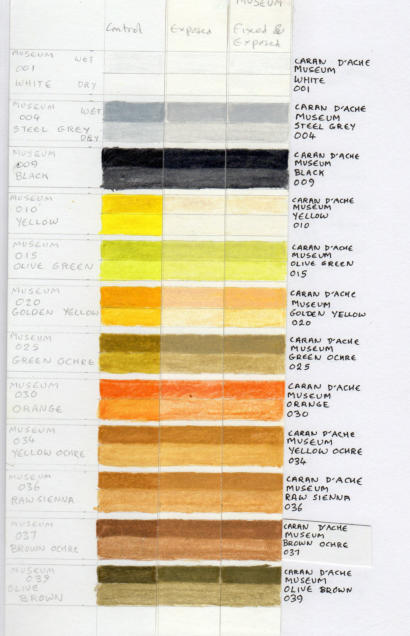
These watercolour pencils are soft and highly soluble. They do tend to be expensive.
In this set of watercolour pencil samples the top example of each colour is the ‘wet’ sample after water was applied to the original dry pigment. The bottom one is the ‘dry’ pigment, untouched with water.
Some of the colours are little changed, but all show some effect from the light. Bear in mind that CDA Museum are a soft and strongly pigmented watercolour pencil made to a modern formula to resist fading. This test sample is very good for an aquarelle pencil.
We can see in this set of strips how even a steel grey 004 ( second strip ) can be faded
Black 009 is virtually unaffected
in the Yellow 010 the dry colour has almost bleached out with just a trace left of the water treated pigment left.

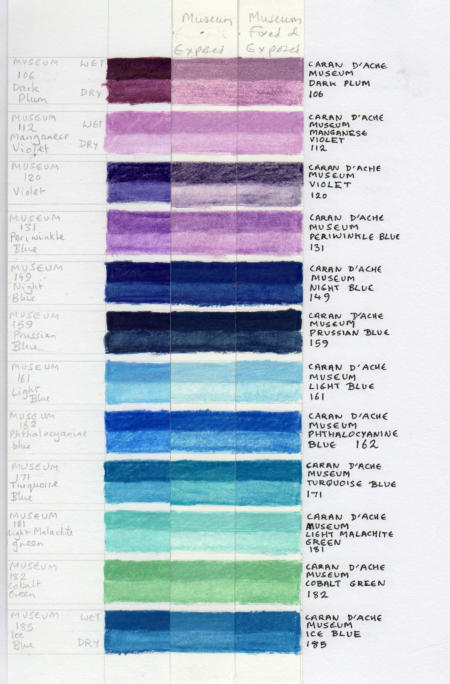




Caran d’Ache Museum were introduced in 2013 as a top of the range soluble pencil. They are highly pigmented and have a soft feel.
Generally the colours are lightfast with just a few being subject to fade in this test.
Yellows and reds are the most likely to be affected. Check the website for their own test results. Individual pencils carry star ratings (up to five) on the side but the worst test result above ( Yellow 10 ) carries a rating of 4*
So this is not a infallible check
Faber Castell Polychromos lightfastness test
Non-soluable, Wax/Oil mixture, long standing brand, available worldwide. Mid price.
As these pencils are non-soluble, there is only a single line for each sample.

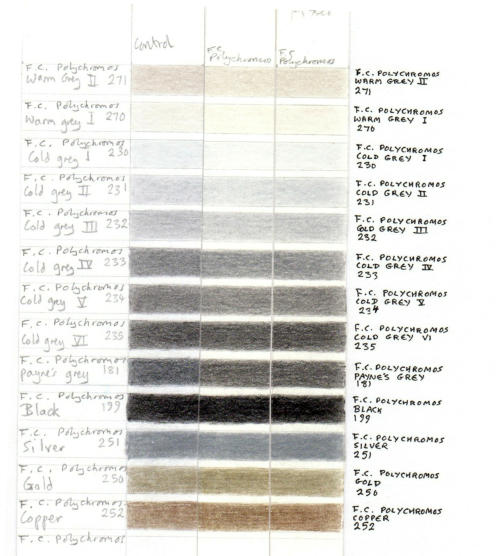
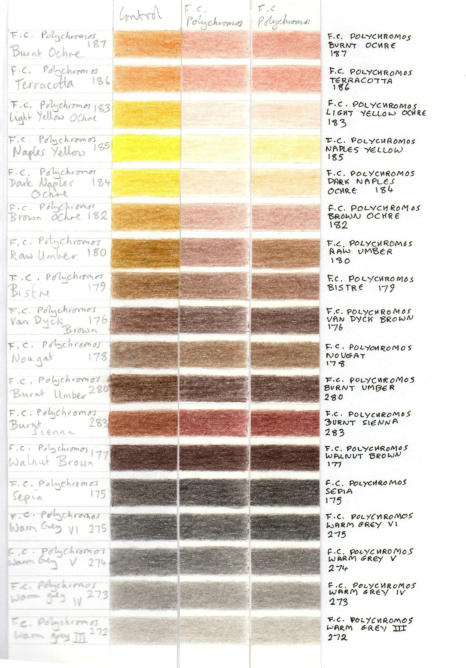




Faber Castell Polychromos are a long established brand, manufactured in Germany and in many other countries where Faber Castell have factories.
The range of 120 colours has been unchanged for many years and the formula is unlikely to have changed a great deal.
The brand is a ‘workhorse’ medium used and loved by many artists and is readily available to buy.
These tests show that many groups of colours fade badly in strong sunlight with the yellows and mauves disappearing competely if they are not protected.
This test shows that this highly respected brand needs care in presentation of the end picture to protect it from sunlight
Sanford Prismacolor lightfastness test
Non soluble, wax/oil mixture. Long standing brand, readily available in the USA and online. Mid price.
The first set of lightfastness test samples show here are the complete set as manufactured in Mexico.
BELOW this complete set is a smaller set of around 60 colours from the original USA manufacture. You may be interested to see how the two formulas compare.
NOTE they were not tested at the same time, so light strength is different.



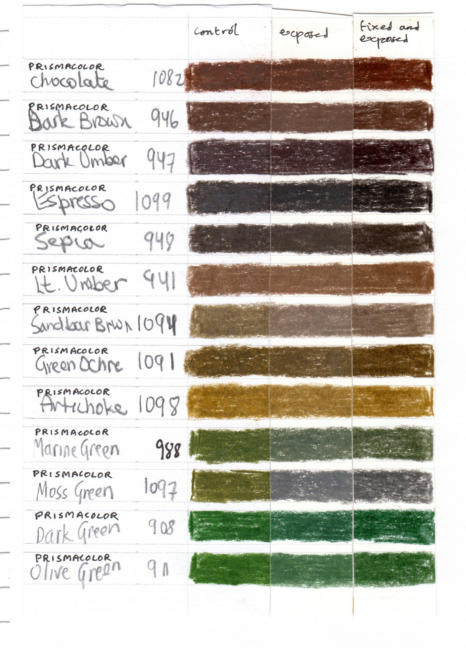





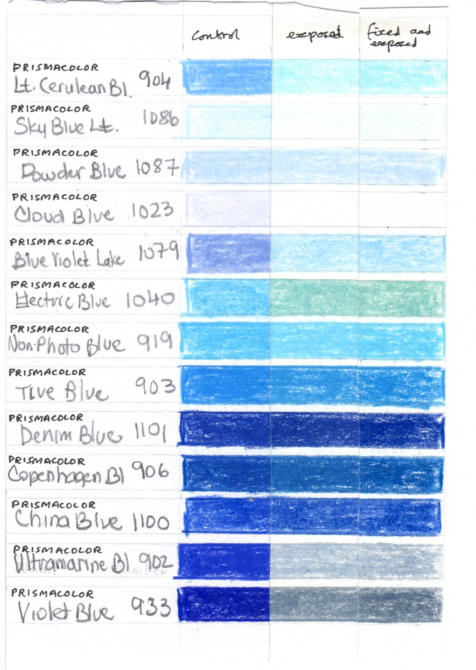
Factors that need to be considered in the results shown above is that many ‘ earth ‘ colours ( the browns ) are naturally lightfast and the least lightfast are usually the yellows, mauves and pinks.
Any coloured pencil that is light in strength is often low in actual pigment content as the main colour is frequently mixed with white to get the paler tint. Blacks will be fairly robust.
Some of the colours change considerably in strong light - see the Sunburst Orange (917) and Yellowed Orange (1002) in the examples above marked (A)
If you think this must be a mistake, it isn’t. If you look below at the separate test on the USA manufactured pencils completed at a different time, you will see the same colour shift ( B )
Many of the paler colours totally disappear - a common situation with coloured pencils using older formulations or cheaper pigments.
The observant among you will notice that the second set of Prismacolor lightfastness test charts shown below include only 62 results .
This test was on the older USA manufactured pencils and was carried out on the colour pencils available. The yellowed Orange referred to in the note above is repeated three times in these results and is no better for it !
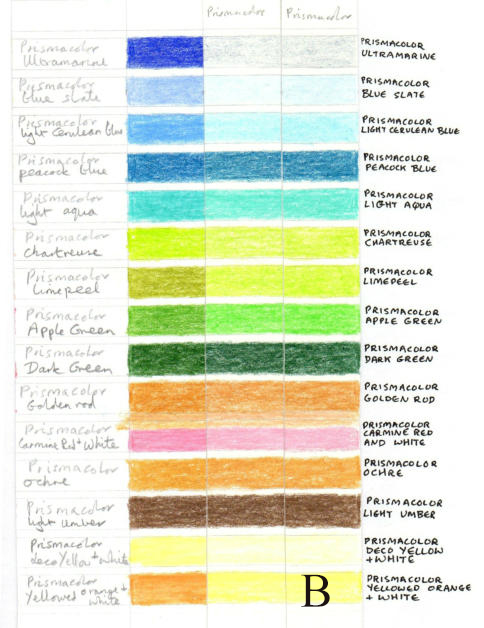



This is probably a good point to repeat that older formula coloured pencils may well have poorer lightfast test results, particularly in the paler colours.
This does not mean that new brands are much better - as cost of pigments also comes into the frame, and manufacturers can only stay in business if they make a profit. Going purely for lightfastness can result in pigments being used that are gritty and dry to the feel of the artist. There is no simple solution. Caran D’Ache Luminance goes for lightfastness as a priority, but as a result, we lose some of the brighter and more ‘botanical’ colours.
You tend to get what you pay for and if you are serious about the life of your pictures, you will ensure you check the ratings of the pencils you use.
Manufacturer’s ratings are useful, if that is all you have.
Derwent Coloursoft lightfastness test
Non soluble, wax/oil mixture. Soft - a competitor for Prismacolor. Mid price.
This test is not of a complete set but is indicative of the general performance in strong light.




The 50 colours shown here are a part set of the full 72 marketed by Derwent.
As with other brands you will note that the pale pinks blues and yellows suffer most from strong light.
The Derwent ARTIST range shown below is a much older and harder formula and has been on sale for many years. It is a stalwart with botanical illustrators
Derwent Artist lightfastness test
Non soluble wax based pencil with a hard feel.


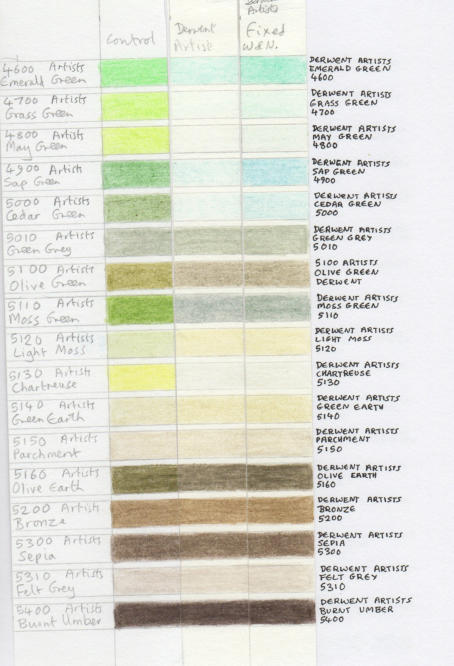

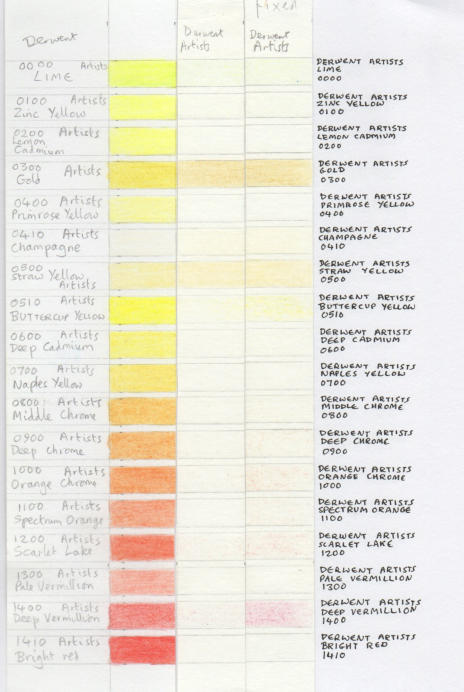
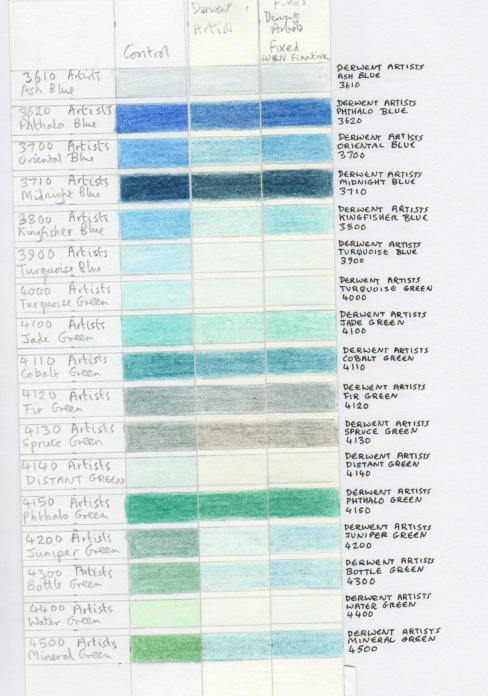

Once again the durability of the natural earth colours ( the brown and dark oranges ) is clear. One would expect an old formula pencil such as these would suffer with fade in the pale tints, but the reds and yellows in the second chart ( above ) have almost all disappeared.
Derwent’s new harder wax type pencil is Procolour and a set of these is currently under test. The results should be available to post by the end of September. Although Procolour is a newly formulated brand, there are a number of low lightfast colours in the range and care is required over some of the paler colours.
Royal Talens Van Gogh lightfastness test
(A Sakura Brand) Wax and watercolour - medium to hard.
These pencils enjoy a unique selling point in that they aim for lightfastness and are manufactured to comply with ASTMS 6901.
This is the lightfastness rating that was established in the USA to provide a rigorous grade for art materials.
ASTMS 6901 is also the grade which Caran d’Ache Luminance was made to comply with, and the Coloured Pencils from this Talens range are reliable, less likely to fade than most brands, and - what is important - are not expensive. This is not a ‘Van Gogh Promotion’ but you can look at the results for yourself, make a decision, and check out the prices.
For more information and suppliers in the UK see the Van Gogh page on this site.
The first set of tests shows the results comparing Van Gogh pencils from the wax range and the watercolour range as pairs and the effect of light on the unfixed samples (Col umn 2) and the fixed samples (column 3).
You will see that mostly there is little impact from strong light with just one or two colours affected. The first set of tests shows the results on part of the range.
The second set of lightfastness tests shows the full set of 60 watercolour Van Gogh coloured pencils on Strathmore w/c paper with water applied and then the usual mediterranean region summer sun.
Watercolour pencils often suffer lower lightfastness than their equivalent non soluble cousins.
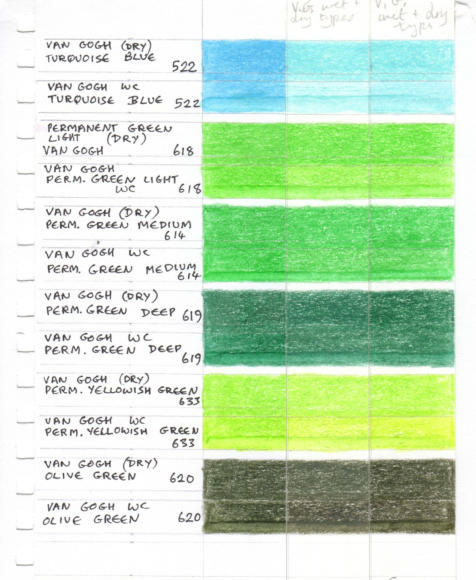

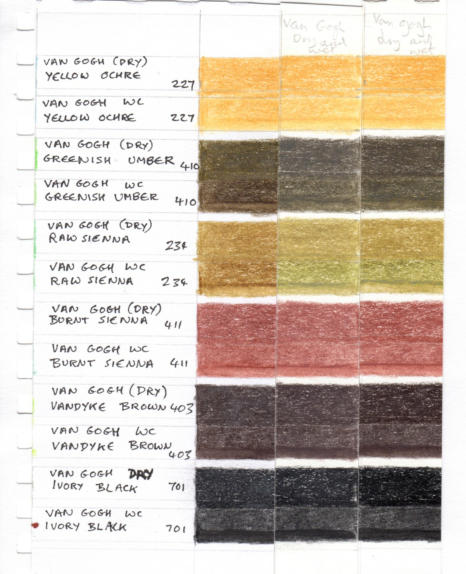
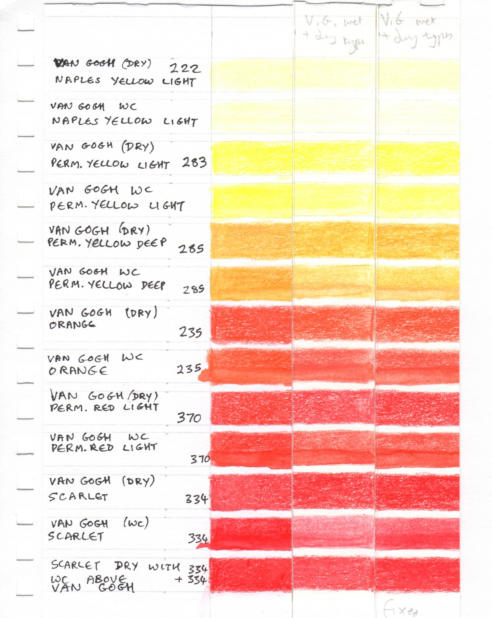
The top sample in each case is the non soluble dry pencil the lower sample the watercolour one.
Now, if you look at the sets of samples below, of the full range, you will see that there is not nearly as much fade in some of the examples as you might expect. Usually, Watercolour pencil colour can be expected to perform less well against wax type with the same pigments.
Addition of water to the samples displayed above, before testing, shows up the way watercolour pencils become much more vibrant after wetting. There is one final sample at the end which shows the yellow part of the watercolor pencil range tested in dry state.
You will see that the low fade quality is very similar even when looking at colours which are most likely to suffer fading.
Van Gogh Watercolour pencils used wet - Full range



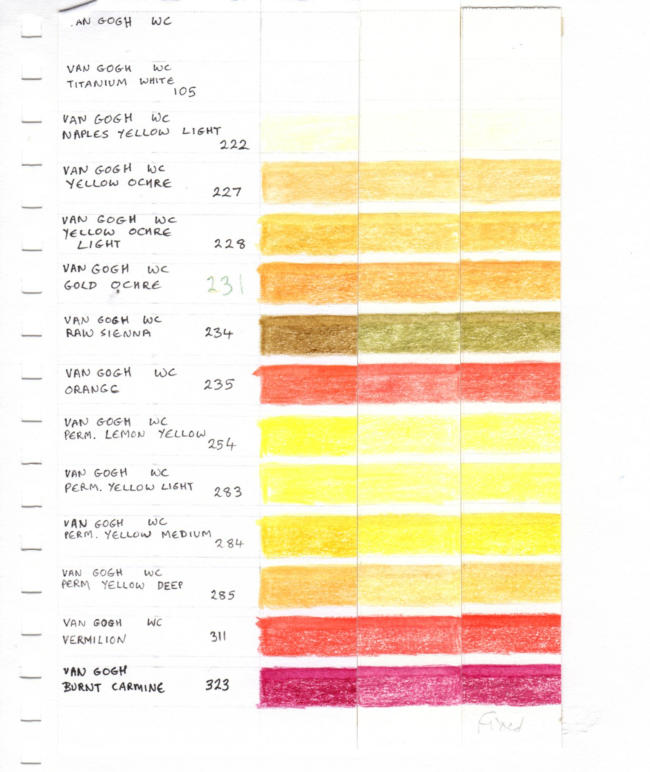
The fourth lightfastness test chart shows the "dry" sample of some of the colours in the other Van Gogh watercolour charts, tested out in the strong sunlight.
You would expect the yellows to suffer from the strong sunlight, and they have, but not notably.
More lightfastness test results - by colour
On the next page are a further set of test results, and these are batched in colour and type groups so that you can compare how a range of brands with similar colours responded to the same light testing. You may find the results shown interesting.

